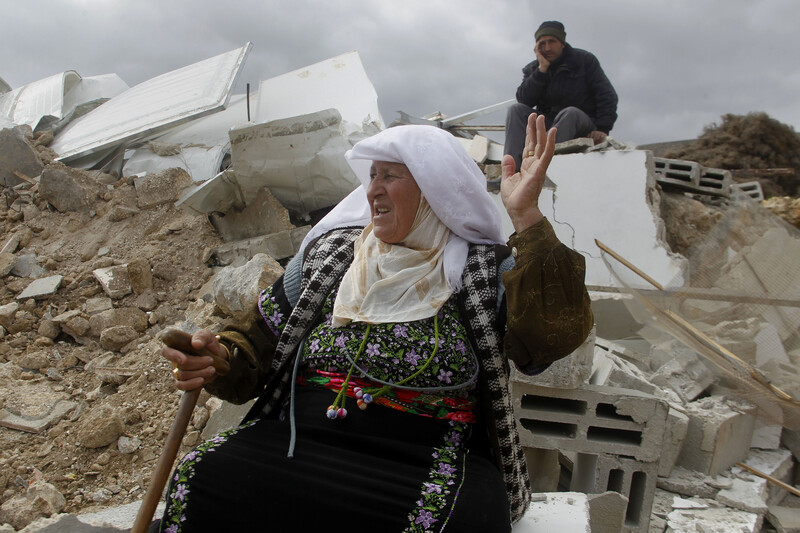Rights and Accountability 3 February 2016

A Palestinian woman sits on the ruins of her house in the West Bank after it was demolished by Israeli occupation forces on 2 February. It was one of two dozen homes demolished by Israeli occupation forces in Jenbah, in the South Hebron Hills, making 100 people homeless.
APA imagesOn Tuesday morning the Israeli army demolished 23 Palestinian homes in two villages in the South Hebron Hills, leaving 100 people homeless.
Breaking the Silence, the Israeli group of former soldiers, called yesterday’s actions the largest demolition to take place in over a decade in the occupied West Bank.
The demolitions were carried out in an area Israel declared a closed military zone as far back as the 1970s.
Thirty square miles in size, it includes a dozen villages where Palestinians have lived for generations.
Residents of the area have resisted Israeli efforts to expel them for years. In the meantime, Israel has allowed Jewish settlements in the area to flourish.
Called Firing Zone 918 by Israel, the cluster of villages is known by Palestinians as Masafer Yatta.
Another twenty homes and buildings in the area are also imminently slated to be razed, but lawyers for the villages obtained a court injunction preventing further demolitions until next week.
Residents have been living with the threat of forcible expulsion for the last 17 years.
In 1999 the Israeli army issued its first evacuation orders to the villagers. After the Association for Civil Rights in Israel and attorney Shlomo Lecker petitioned Israel’s high court, the residents were permitted to temporarily return on condition they entered an arbitration process with Israeli occupation authorities.
Unilateral termination
After negotiations began, Israel offered to transfer the villagers to another area. The villagers refused.
The Association for Civil Rights in Israel and attorney Shlomo Lecker again petitioned against any forcible transfer. On Monday, Israel unilaterally terminated the ongoing mediation.
COGAT, the army’s unit that rules the Palestinian population in Area C, stated that “enforcement measures were taken against illegal structures and solar panels built within a military zone.”
In 2012, Israel announced it had reduced the scale of its firing zone, allowing four of the Masafer Yatta villages to remain.
But if completed, the demolitions would leave a total of 1,000 people homeless across eight other villages, according to Israeli human rights group B’Tselem.
Israel has prohibited the construction of any permanent structures in its self-declared firing zone.
Israel claims that the area is essential to train Israeli military forces.
Masafer Yatta lies in Area C, the approximately 60 percent of the West Bank that is under complete Israeli military and civilian control under the terms of the 1993 Oslo accords.
International law prohibits the forcible transfer or displacement of an indigenous population by an occupying power.
Over the course of 2015, Israel demolished 521 structures in Area C as well as in East Jerusalem, displacing 636 people, according to the UN monitoring group OCHA.
The vast majority of these demolitions were carried out on the grounds that Palestinians did not have permission to build. Between 2010 and 2014, only 1.5 percent of applications for building permits in Area C were approved by Israeli occupation authorities.
No warning
The villages that lie in Masafer Yatta are impoverished and Israel has refused to allow them to connect to water and electricity services.
They depend entirely on solar panels or communal generators for electricity and the children must travel up to six miles over a rocky terrain to reach the nearest school.
Israel has issued demolition orders for 15 cisterns, 19 toilets and cesspools that were built with the assistance of the UK government.
Tuesday’s demolitions came with little warning.
According to The Guardian, the military marked villagers’ homes the night before. Residents were left to guess what lay ahead by overhearing soldiers speaking in Hebrew.
Following the demolitions on Tuesday, villagers retrieved furniture from the ruins of their homes and set up tents, The Guardian reported.
Other families moved their belongings into caves, which will provide shelter.
Khalil Musa was born in 1942 in Khirbet al-Markaz, one of the villages the Israeli army wants to remove.
He told B’Tselem that despite the hardships of living in the poor and isolated community, “The families work the land and raise sheep and we have a small, perfect community here.”
“Our way of life is primitive and difficult, but we have strong ties to this place and have no other alternative,” Musa added. “We are connected to the land and the livestock, which are our livelihood.”






Comments
GOD help these poor Palestinians.
Permalink Betty replied on
Let the world wake up and realize what a horrific thing is happening to them.
the shallowest roots
Permalink tom hall replied on
The Israelis refer incessantly to their own connection with the land, despite being for the most part recent arrivals. At the same time, they destroy the homes and livelihoods of people with an uninterrupted tenure and deep attachment to the land stretching back millennia. In always striving to efface the Palestinian presence, Israel exposes itself each time as a colonial enterprise. The criminal destruction of homes in Jenbah and throughout the West Bank- unresisted by Abbas and company, it seems- must be included in the list of factors obliging the world to apply sanctions against Israel.
Dream on...
Permalink Louis replied on
An apartheid state cannot survive. Embracing racism as a matter of public policy is beyond sick.
Home demolitions in Jenbah area
Permalink Janet Gillmar replied on
Tom Hall expresses the situation very well.
Some history: Among other measures intended to break the back of the "Great Arab Revolt" in the latter 1930s, Britain demolished homes. This is reported in the book The Palestinian People, by Baruch Kimmerling and Joel Migdal, 2 Jewish professors, one Israeli and one American, Harvard University Press, 2003.
The Israeli state knows it
Permalink Caitlin Ni Chonaill replied on
The Israeli state knows it can't get away with expelling the Palestinians en masse and all at once, so it operates a gradualist, step-by-step process of expulsion using measures and laws it has conveniently put in place, such as the pretext used here of 'creating a military zone'. In other places it may be 'to create a green zone'. These 'official' reasons are designed to keep the international political establishment quiet and make it easier for them to do nothing. However, the world is not fooled. We in the Palestinian solidarity movement internationally accuse the US and the EU of connivance in what amounts to criminal theft of land and 'death by a thousand cuts' for the Palestinians.